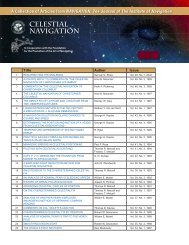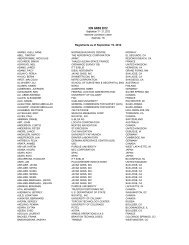The N5G Inertial Navigation System in the B-52 Hound DogMissile A ...
The N5G Inertial Navigation System in the B-52 Hound DogMissile A ...
The N5G Inertial Navigation System in the B-52 Hound DogMissile A ...
You also want an ePaper? Increase the reach of your titles
YUMPU automatically turns print PDFs into web optimized ePapers that Google loves.
<strong>The</strong> <strong>N5G</strong> <strong>Inertial</strong> <strong>Navigation</strong> <strong>System</strong> <strong>in</strong> <strong>the</strong> B-<strong>52</strong> <strong>Hound</strong> <strong>DogMissile</strong><br />
A <strong>System</strong> Overview<br />
Prepared by <strong>the</strong> ION Editorial Review Committee,<br />
assisted by Jim Noll, Neil Wood and Charles White<br />
Background – Throughout <strong>the</strong> duration of <strong>the</strong> Cold War, <strong>the</strong> B-<strong>52</strong> Bomber<br />
was an essential element of America’s triumverate strategic arsenal – air, sea<br />
and land. In conjunction with Polaris submar<strong>in</strong>es travers<strong>in</strong>g <strong>the</strong> ocean depths<br />
and M<strong>in</strong>uteman missiles deep <strong>in</strong> silos under <strong>the</strong> ground, <strong>the</strong>re were always<br />
B-<strong>52</strong>s high <strong>in</strong> <strong>the</strong> air ready to launch missiles at a signal from Headquarters.<br />
<strong>The</strong> strategic weapon carried by <strong>the</strong> B-<strong>52</strong> was <strong>the</strong> GAM-77 <strong>Hound</strong> Dog<br />
missile. Although <strong>the</strong> B-<strong>52</strong> traditionally carried conventional ordnance <strong>in</strong> its<br />
bomb-bay, <strong>the</strong> strategic <strong>Hound</strong> Dog was a self-propelled, maneuverable,<br />
self-guided, air-to-ground standoff missile, mounted one under each w<strong>in</strong>g of<br />
<strong>the</strong> B-<strong>52</strong>. <strong>The</strong> mission of <strong>the</strong> <strong>Hound</strong> Dog-equipped B-<strong>52</strong>s was to aid <strong>in</strong> <strong>the</strong><br />
strategic offensive through destruction of enemy targets without expos<strong>in</strong>g <strong>the</strong><br />
aircrew or <strong>the</strong> B-<strong>52</strong> to enemy defenses.<br />
<strong>The</strong> <strong>Hound</strong> Dog missile was guided to its target by a highly-accurate onboard<br />
<strong>Inertial</strong> <strong>Navigation</strong> <strong>System</strong> (INS): <strong>the</strong> <strong>N5G</strong> all-attitude stable platform<br />
manufactured by <strong>the</strong> Autonetics Division of North American Aviation. <strong>The</strong><br />
<strong>N5G</strong> was an outgrowth of <strong>the</strong> INS <strong>in</strong>tended for <strong>the</strong> Navajo missile.<br />
Guidance by <strong>the</strong> use of <strong>in</strong>ertial navigation was judged by <strong>the</strong> military to be a<br />
critical necessity <strong>in</strong> America’s wag<strong>in</strong>g of strategic warfare. <strong>The</strong> <strong>in</strong>ertial<br />
navigation system was, and still is, <strong>the</strong> only navigation means which is totally<br />
self-conta<strong>in</strong>ed, and <strong>in</strong>dependent of external <strong>in</strong>puts. Thus, it cannot be<br />
jammed, spoofed, or affected by anyth<strong>in</strong>g <strong>the</strong> enemy may seek to do. <strong>The</strong><br />
U.S. had <strong>in</strong>vested heavily <strong>in</strong> INS development <strong>in</strong> <strong>the</strong> early years of <strong>the</strong> Cold<br />
War, and <strong>the</strong> success of this technology proved extremely advantageous.<br />
<strong>The</strong> GAM-77 program go-ahead was given <strong>in</strong> 1958 and <strong>the</strong> system became<br />
operational <strong>in</strong> <strong>the</strong> late 1959. Five B-<strong>52</strong>s per squadron on alert status were<br />
equipped with two GAM-77s each, and rotated through a 14-day alert period.<br />
1
Fig. 1, GAM-77 <strong>Hound</strong> Dog Missile<br />
GAM-77 <strong>Hound</strong> Dog Missile. - (See Fig. 1.) Each of <strong>the</strong> two GAM-77s is<br />
mounted on a pylon under a w<strong>in</strong>g, <strong>in</strong>board of <strong>the</strong> <strong>in</strong>ner eng<strong>in</strong>e. <strong>The</strong> missile is<br />
powered by a J-<strong>52</strong> turbojet, pod-mounted eng<strong>in</strong>e, mounted below <strong>the</strong> missile<br />
body. <strong>The</strong> pylon attach<strong>in</strong>g <strong>the</strong> missile to <strong>the</strong> w<strong>in</strong>g conta<strong>in</strong>s <strong>the</strong> astrotracker<br />
and stays with <strong>the</strong> B-<strong>52</strong> after launch separation.<br />
2
Missile <strong>Navigation</strong> and Control<br />
Guidance <strong>System</strong> - <strong>The</strong> purpose of <strong>the</strong> missile guidance system is to cont<strong>in</strong>uously<br />
calculate <strong>the</strong> position of <strong>the</strong> missile and <strong>the</strong>reby provide control signals to <strong>the</strong><br />
missile’s flight control system for guidance of <strong>the</strong> missle to its <strong>in</strong>tended target.<br />
<strong>The</strong> astrotracker and <strong>the</strong> INS are two subsystems which make up <strong>the</strong> guidance<br />
system, and are <strong>in</strong>terconnected before missle separation from <strong>the</strong> aircraft pylon.<br />
<strong>The</strong> astrotracker (located <strong>in</strong> <strong>the</strong> pylon) searches for and <strong>the</strong>n tracks <strong>the</strong> manually<br />
selected sun or star for head<strong>in</strong>g alignment of <strong>the</strong> INS dur<strong>in</strong>g captive flight. <strong>The</strong><br />
purpose of <strong>the</strong> astrotracker is to provide <strong>the</strong> <strong>in</strong>itial azimuth alignment reference for<br />
<strong>the</strong> INS. This is accomplished by search<strong>in</strong>g for and track<strong>in</strong>g a selected star (nighttime,<br />
or <strong>the</strong> sun (day-time). (See figure 2)<br />
3
After <strong>in</strong>itial alignment via signals received from <strong>the</strong> B-<strong>52</strong>, <strong>the</strong> missile can be<br />
launched, and its guidance system will operate as a pure, self-directed <strong>in</strong>ertial<br />
system, with <strong>the</strong> INS provid<strong>in</strong>g <strong>the</strong> necessary steer<strong>in</strong>g and control signals required<br />
to guide <strong>the</strong> missile to <strong>the</strong> designated target.<br />
<strong>The</strong> <strong>Hound</strong> Dog missile is equipped with an <strong>N5G</strong> <strong>Inertial</strong> <strong>Navigation</strong> <strong>System</strong><br />
(INS). <strong>The</strong> INS features a triad of three very accurate accelerometers aligned<br />
along <strong>the</strong> earth’s coord<strong>in</strong>ate axes (north-south and east-west, relative to True<br />
North) and ma<strong>in</strong>ta<strong>in</strong>ed <strong>in</strong> this orientation by <strong>the</strong> gyroscopes <strong>in</strong> <strong>the</strong> <strong>N5G</strong> stable<br />
platform <strong>in</strong> which <strong>the</strong>y are housed. After activation <strong>the</strong> outputs of <strong>the</strong><br />
accelerometers are <strong>in</strong>tegrated once to obta<strong>in</strong> <strong>the</strong> change <strong>in</strong> velocity (V = at) along<br />
each axis. <strong>The</strong> resultant velocities are <strong>the</strong>n <strong>in</strong>tegrated to obta<strong>in</strong> <strong>the</strong> distance<br />
travelled (d = vt) along each axis. <strong>The</strong> <strong>N5G</strong> INS <strong>the</strong>reby provides data on <strong>the</strong><br />
missile’s acceleration, velocity and position to <strong>the</strong> on-board guidance, control,<br />
arm<strong>in</strong>g and fuz<strong>in</strong>g systems. This <strong>N5G</strong> stable platform is physically located at <strong>the</strong><br />
approximate center of gravity of <strong>the</strong> missile. When <strong>the</strong> missile is attached to <strong>the</strong><br />
pylon, <strong>the</strong> platform is mounted directly underneath <strong>the</strong> pylon-mounted astrotracker.<br />
(See Fig. 2-A)<br />
4
<strong>The</strong> level<strong>in</strong>g operation for <strong>the</strong> <strong>N5G</strong> requires <strong>the</strong> comparison of north-oriented<br />
velocities from <strong>the</strong> B-<strong>52</strong> nav system with <strong>the</strong> missile’s platform-oriented <strong>in</strong>ertial<br />
values; missile position, ma<strong>in</strong>ta<strong>in</strong>ed by <strong>the</strong> computer <strong>in</strong> terms of platform x, y, and<br />
z factors, are related to a true-north-oriented earth.<br />
<strong>The</strong> primary means for azimuth alignment employs celestial observations made by<br />
<strong>the</strong> pylon-<strong>in</strong>stalled astrotracker. Celestial bodies are used as an azimuth reference<br />
from which to measure <strong>the</strong> azimuth orientation of <strong>the</strong> stable platform (See Fig. 3).<br />
Alignment accuracy of <strong>the</strong> guidance system depends upon accurate <strong>in</strong>itial <strong>in</strong>puts<br />
from <strong>the</strong> navigator’s data panels of <strong>the</strong> Greenwich Hour Angle, Sidereal Hour<br />
Angle, and Decl<strong>in</strong>ation for <strong>the</strong> selected celestial body.<br />
6
B-<strong>52</strong> <strong>Navigation</strong> and Tie-<strong>in</strong> Signals to <strong>the</strong> Missile<br />
<strong>The</strong> primary head<strong>in</strong>g reference <strong>in</strong> <strong>the</strong> B-<strong>52</strong> is its AJN-8 Head<strong>in</strong>g and Vertical<br />
Reference <strong>System</strong>, which <strong>in</strong>corporates a stable platform and provides accurate<br />
True Head<strong>in</strong>g, <strong>the</strong> basic source for which is <strong>the</strong> MD-1 astrocompass. Ground<br />
speed values from <strong>the</strong> Doppler are required for optimum platform operation. To<br />
determ<strong>in</strong>e <strong>the</strong> aircraft ground speed, <strong>the</strong> Doppler reflects a radar signal off <strong>the</strong><br />
terra<strong>in</strong> below <strong>the</strong> aircraft.<br />
In magnetic-slaved operation, <strong>the</strong> N-1 compass provides magnetic head<strong>in</strong>g<br />
(referenced to <strong>the</strong> flux valve) and feeds it to <strong>the</strong> AJA-1 True Head<strong>in</strong>g converter,<br />
where magnetic variation is calculated, based on <strong>the</strong> aircraft’s position, and <strong>the</strong><br />
result<strong>in</strong>g True Head<strong>in</strong>g is sent down to <strong>the</strong> astrotracker <strong>in</strong> <strong>the</strong> missile pylon.<br />
Corrections for earth’s rate, as well as <strong>the</strong> ongo<strong>in</strong>g travel of <strong>the</strong> aircraft over <strong>the</strong><br />
earth’s surface, are cont<strong>in</strong>uously applied to <strong>the</strong> N-1 directional to ma<strong>in</strong>ta<strong>in</strong> it’s<br />
orthogonality to <strong>the</strong> earth’s surface.<br />
<strong>The</strong> secondary head<strong>in</strong>g reference for <strong>the</strong> B-<strong>52</strong>’s Bomb Nav <strong>System</strong> is <strong>the</strong> J-4<br />
compass system. In magnetic mode, <strong>the</strong> same flux valve (magnetic-north sensor) is<br />
used with <strong>the</strong> AJN-8 platform and <strong>the</strong> N-1 and J-4 directional gyro systems.<br />
<strong>The</strong> outputs of <strong>the</strong> B-<strong>52</strong>’s Bomb-Nav <strong>System</strong> are analog and are fed to an A/D<br />
converter for <strong>in</strong>putt<strong>in</strong>g <strong>in</strong>to <strong>the</strong> missile’s Verdan digital computer,<br />
At any time prior to missile release, target coord<strong>in</strong>ates can be <strong>in</strong>serted or changed<br />
and ei<strong>the</strong>r straight-l<strong>in</strong>e flight or a pre-programmed maneuver can be selected.<br />
Missile Flight Control <strong>System</strong> (FCS) –<br />
<strong>The</strong> GAM-77 flight control system is a modified autopilot, consist<strong>in</strong>g of <strong>in</strong>ertial<br />
<strong>in</strong>struments, <strong>the</strong> Verdan digital computer, an air data computer, a radar, a terra<strong>in</strong><br />
avoidance computer, and control surfaces driven by actuators. <strong>The</strong> system’s<br />
electro-hydraulic servo system utilizes guidance system commands, pitot-static<br />
signals, rate gyros, and verical reference gyro signals to provide automatic<br />
stabilization and control of <strong>the</strong> missile through all phases of its flight - from time of<br />
launch until detonation of <strong>the</strong> warhead at <strong>the</strong> target.<br />
7
Movement about <strong>the</strong> three axes is controlled by aerodynamic control surfaces.<br />
Control of pitch movement is provided by <strong>the</strong> elevators, roll by <strong>the</strong> ailerons, and<br />
yaw by <strong>the</strong> rudder, <strong>in</strong> a canard configuration. <strong>The</strong>se surfaces, powered by <strong>the</strong><br />
hydraulic actuators, are used to change <strong>the</strong> flight attitude of <strong>the</strong> missile. (See Fig 4)<br />
8
Dur<strong>in</strong>g missile cruise, <strong>the</strong> FCS receives lateral (steer<strong>in</strong>g) signals from <strong>the</strong> guidance<br />
system to physically steer <strong>the</strong> missile. Any undesirable deviation from straight and<br />
level flight will be sensed by <strong>the</strong> vertical gyro, <strong>the</strong> rate gyro, and/or <strong>the</strong> lateral<br />
accelerometer. After launch, <strong>the</strong> missile’s guidance and control systems are totally<br />
<strong>in</strong>dependent and irrevocable.<br />
Operation After Launch<br />
This <strong>in</strong>ertial navigation system cont<strong>in</strong>uously calculates <strong>the</strong> position of <strong>the</strong> missile<br />
with reference to its <strong>in</strong>itial position by measur<strong>in</strong>g missile accelerations from <strong>the</strong><br />
time it is placed <strong>in</strong> operation dur<strong>in</strong>g captive flight. <strong>The</strong> missile’s on-board Verdan<br />
digital computer transmits steer<strong>in</strong>g signals to <strong>the</strong> flight control system.<br />
<strong>The</strong> GAM-77 navigation and control system is capable of execut<strong>in</strong>g any of six<br />
flight-profile modes – <strong>in</strong>putted by <strong>the</strong> B-<strong>52</strong> navigator prior to <strong>the</strong> missile launch –<br />
to optimally guide <strong>the</strong> missile to its target. A typical profile is <strong>the</strong> Hi-Hi-Lo-HI<br />
profile (see Figure 5). Most of <strong>the</strong>se profiles culm<strong>in</strong>ate <strong>in</strong> a Dive mode, whereby<br />
<strong>the</strong> missile is directed to a straight-<strong>in</strong> vertical dive to <strong>the</strong> target.<br />
9
Dur<strong>in</strong>g <strong>the</strong> <strong>in</strong>itial portion of free flight, missile speed, altitude, and stability <strong>in</strong> <strong>the</strong><br />
three axes are controlled by <strong>the</strong> flight control system. When <strong>the</strong> cruise mode is<br />
reached, control <strong>in</strong> <strong>the</strong> lateral plane is accomplished by means of bank angle<br />
commands generated by <strong>the</strong> guidance system. High or low longitud<strong>in</strong>al cruise<br />
control can be selected for <strong>the</strong> missile prior to launch.<br />
Low-level Cruise - When <strong>the</strong> signals applied as pitch command, <strong>the</strong> missile levels<br />
off and ma<strong>in</strong>ta<strong>in</strong>s <strong>the</strong> pre-selected altitude until <strong>the</strong> guidance system detonates <strong>the</strong><br />
warhead over <strong>the</strong> target. <strong>The</strong>re is no dive or verical mode <strong>in</strong> low-level flight.<br />
High-level Cruise - In this mode, <strong>the</strong> missile is commanded to seek <strong>the</strong> referenced<br />
pitot pressure, and descends or ascends (depend<strong>in</strong>g on launch conditions). This<br />
mode cont<strong>in</strong>ues until term<strong>in</strong>ated by a Dive command signal from <strong>the</strong> INS.<br />
Dive - Started by <strong>the</strong> dive-<strong>in</strong>itate signal from <strong>the</strong> INS approximately 30 seconds<br />
from target; <strong>the</strong> eng<strong>in</strong>e is shut down and <strong>the</strong> vertical gyro torqued at a constant rate<br />
to allow <strong>the</strong> airframe to nose over to <strong>the</strong> straight-<strong>in</strong> dive attitude.<br />
SUMMARY – <strong>The</strong> GAM-77 <strong>Hound</strong> Dog missile carried by and launched from <strong>the</strong><br />
B-<strong>52</strong> strategic bomber, is considered to be one of <strong>the</strong> earliest, and most successful,<br />
applications of <strong>Inertial</strong> <strong>Navigation</strong> technology. It was a monumental achievement,<br />
not only <strong>in</strong> how rapidly it was designed, developed and operationally deployed, but<br />
for <strong>the</strong> message of technical competence and superiority it broadcast to <strong>the</strong> world.<br />
<strong>The</strong> B-<strong>52</strong> strategic bomber, armed with <strong>the</strong> GAM-77 <strong>Hound</strong> Dog, was a ma<strong>in</strong>stay<br />
of America’s nuclear arsenal from 1959 until 1976, when <strong>the</strong> Gam-77 was phased<br />
out and replaced by <strong>the</strong> SRAM Missile, and later <strong>the</strong> Air-Launched Cruise Missile.<br />
References:<br />
1. Strategic Air Command Tran<strong>in</strong>g Manual, SACM 50-11 “AGM-28 A/B<br />
Operational Manual” 30 August 1965, issued by HQ-SAC<br />
2. Strategic Air Command Tran<strong>in</strong>g Manual, SACM 55-10 “Combat Tra<strong>in</strong><strong>in</strong>g<br />
and <strong>Navigation</strong> Tactical Procedures” 23 July 1962, issued by HQ-SAC<br />
3. Tech. Order 21-GAM77-2-1 Ma<strong>in</strong>tenance and Operation Data<br />
10
Legacy –<br />
An actual Gam-77 <strong>Hound</strong> Dog missile, removed from its B-<strong>52</strong> support<strong>in</strong>g pylon,<br />
has been pa<strong>in</strong>stak<strong>in</strong>gly restored by museum volunteer staff, and is on full public<br />
display at <strong>the</strong> Travis Air Museum, Fairfield, CA (off Interstate 80, between San<br />
Francisco and Sacramento). An <strong>N5G</strong> <strong>in</strong>ertial navigation system, fitted with a<br />
plastic view<strong>in</strong>g cover, is also on display alongside <strong>the</strong> missile. See Photos.<br />
11







